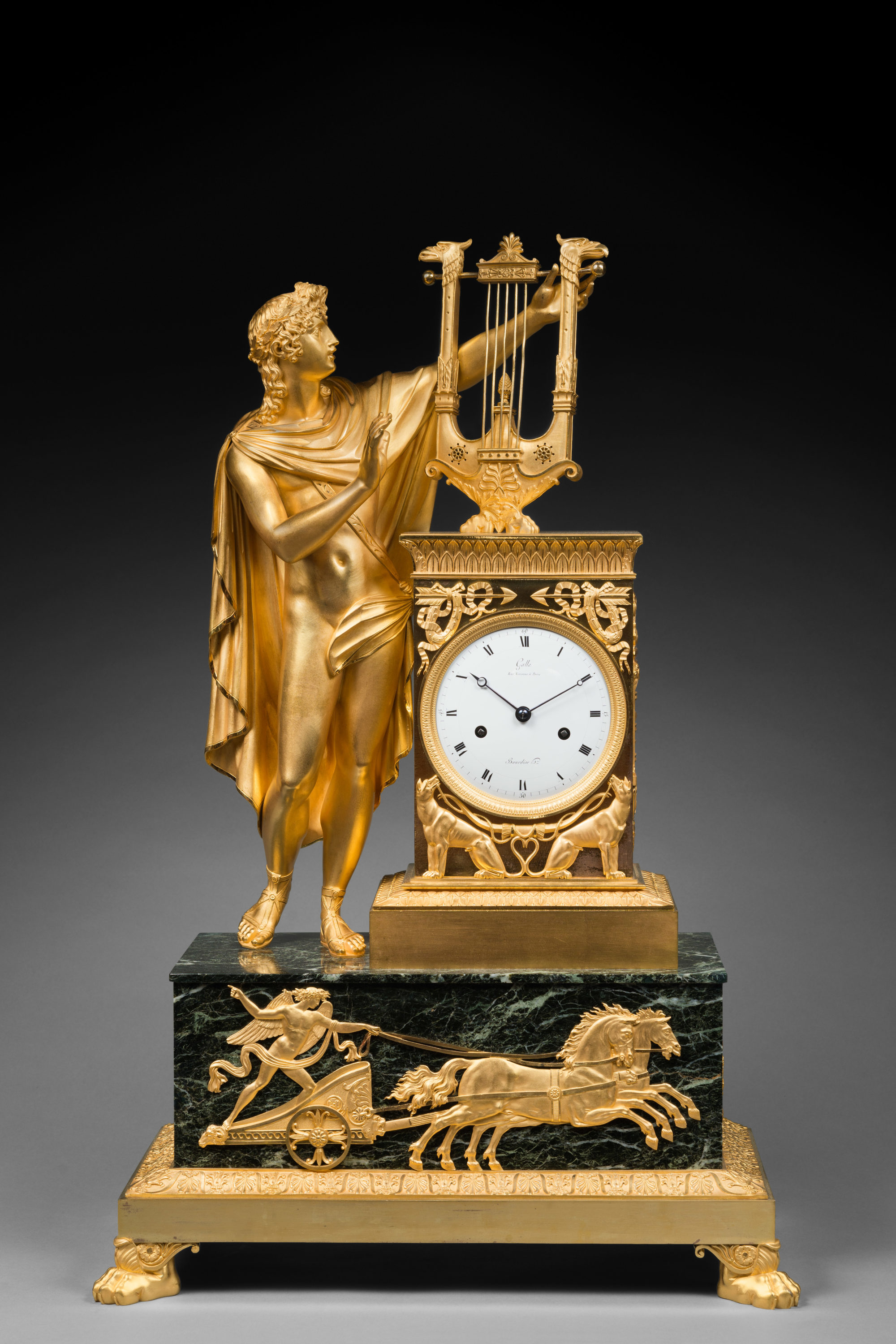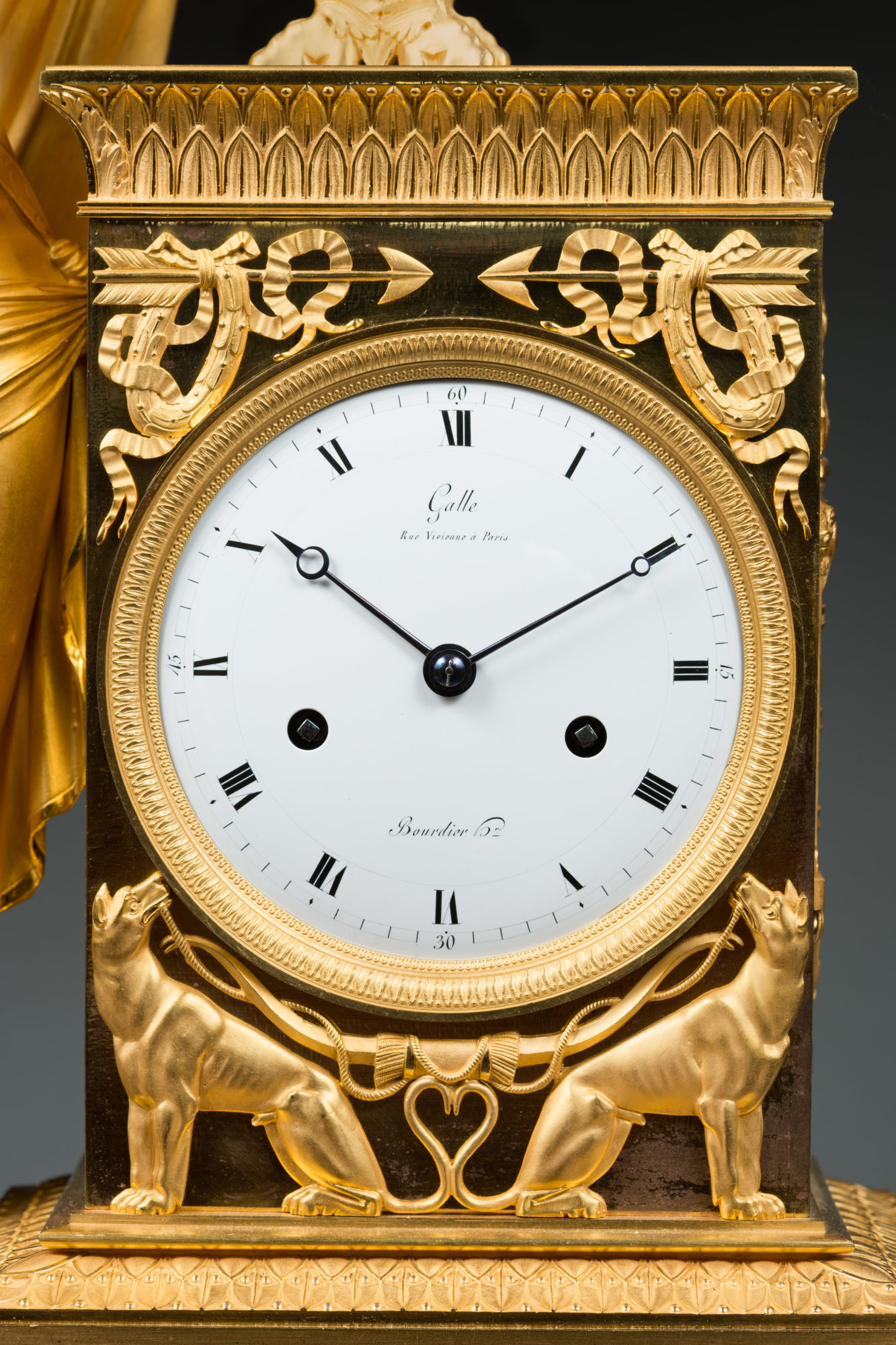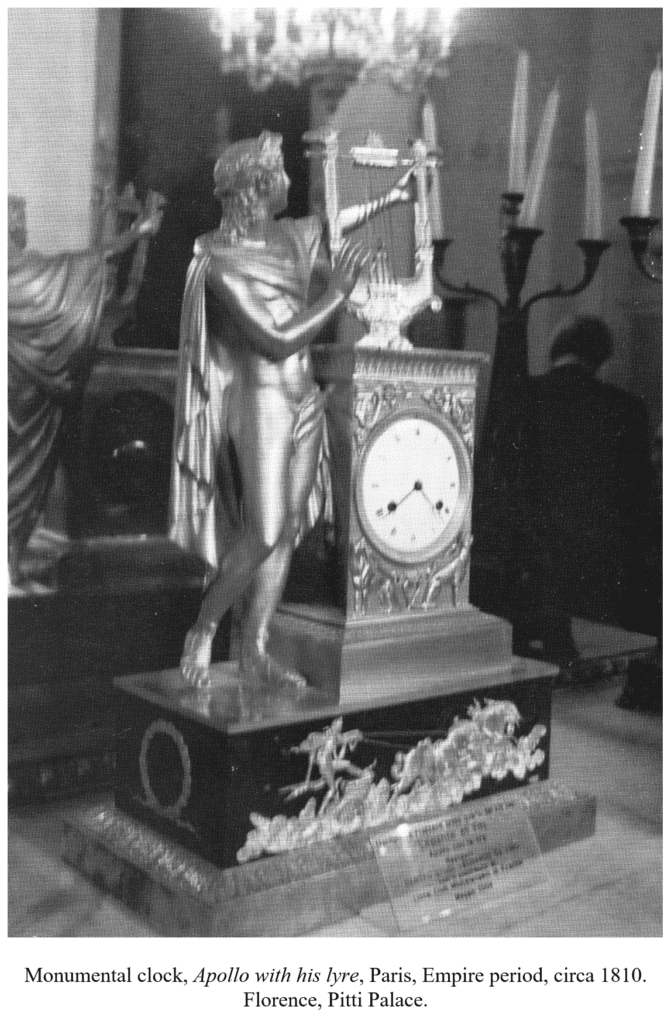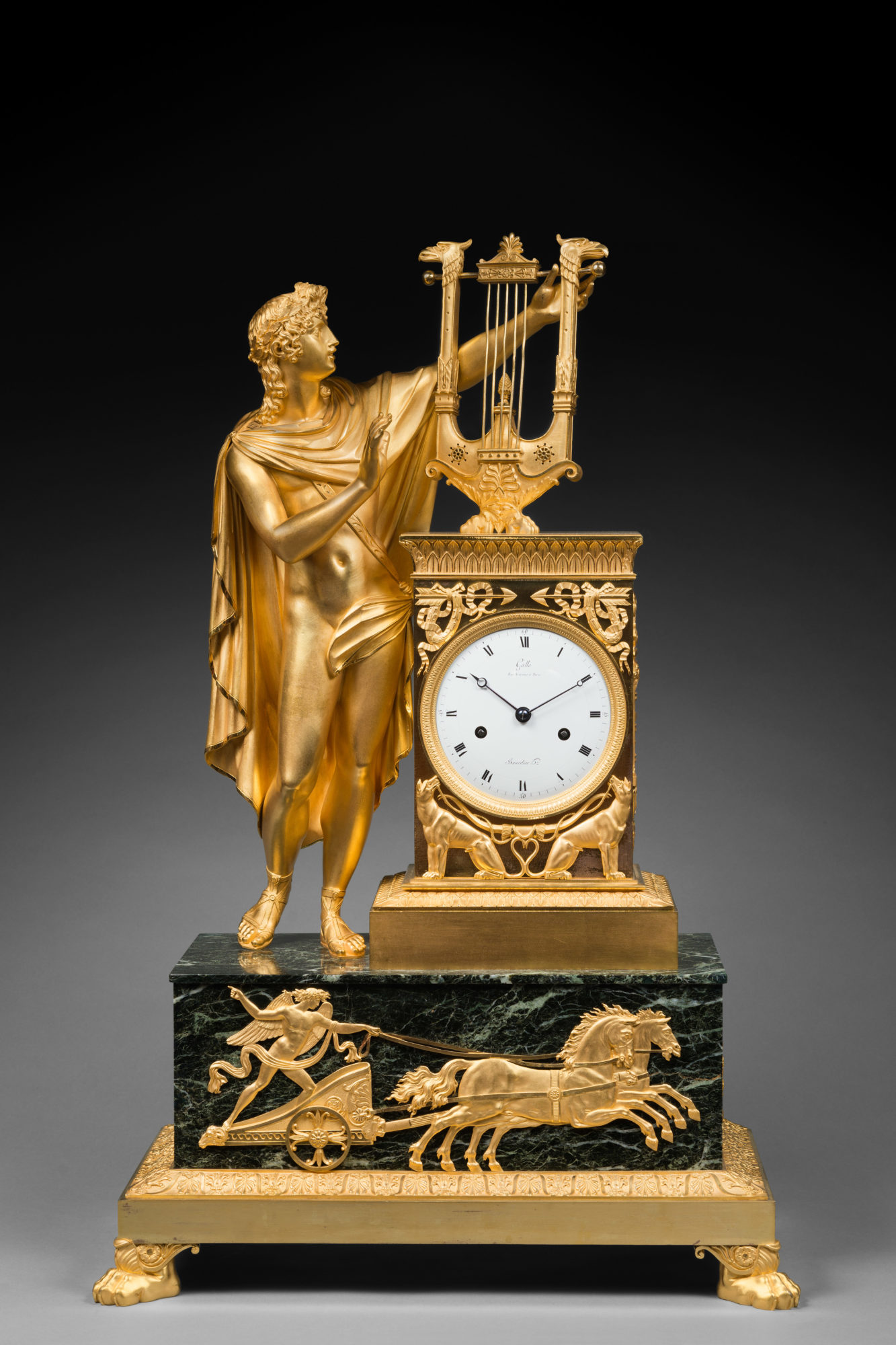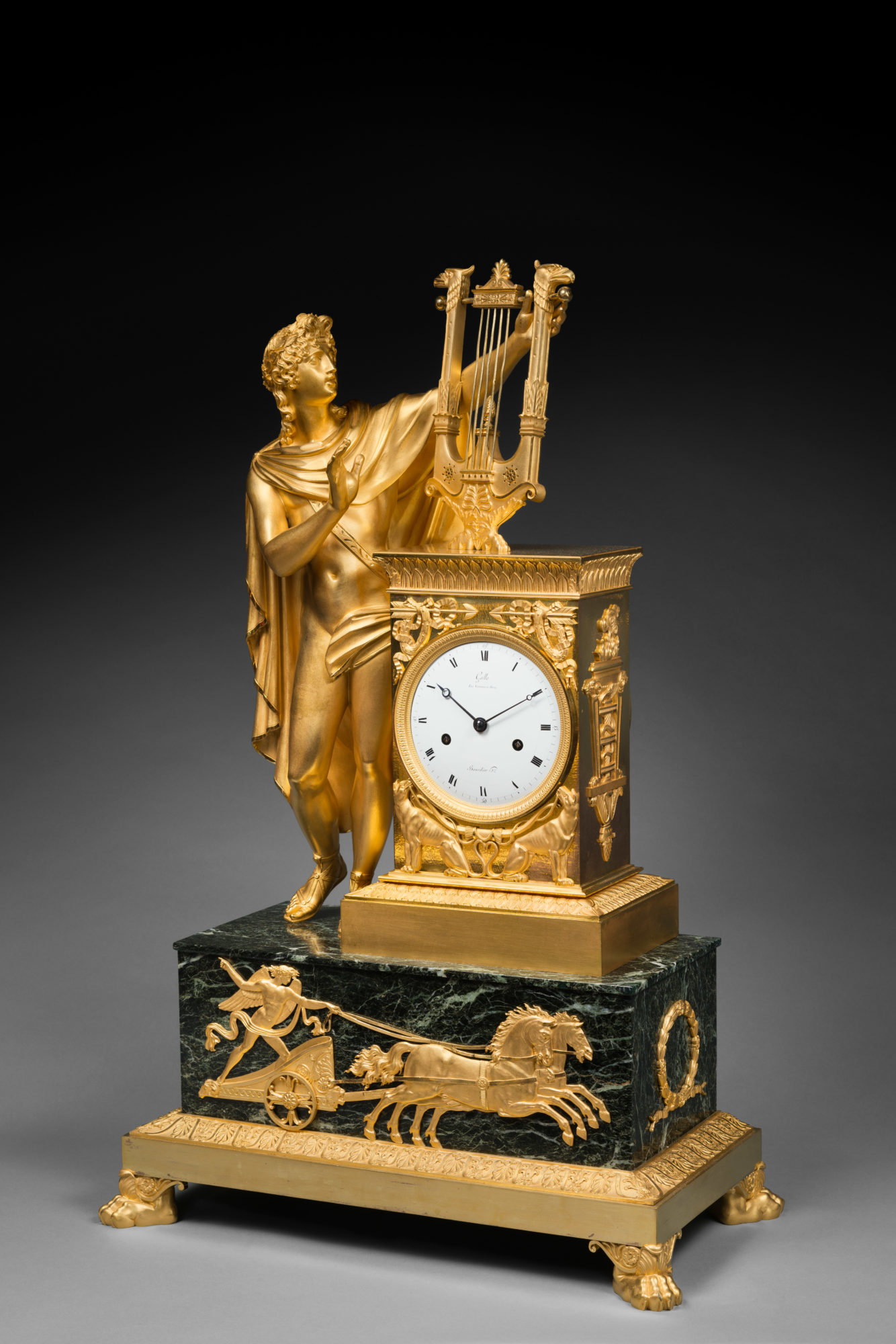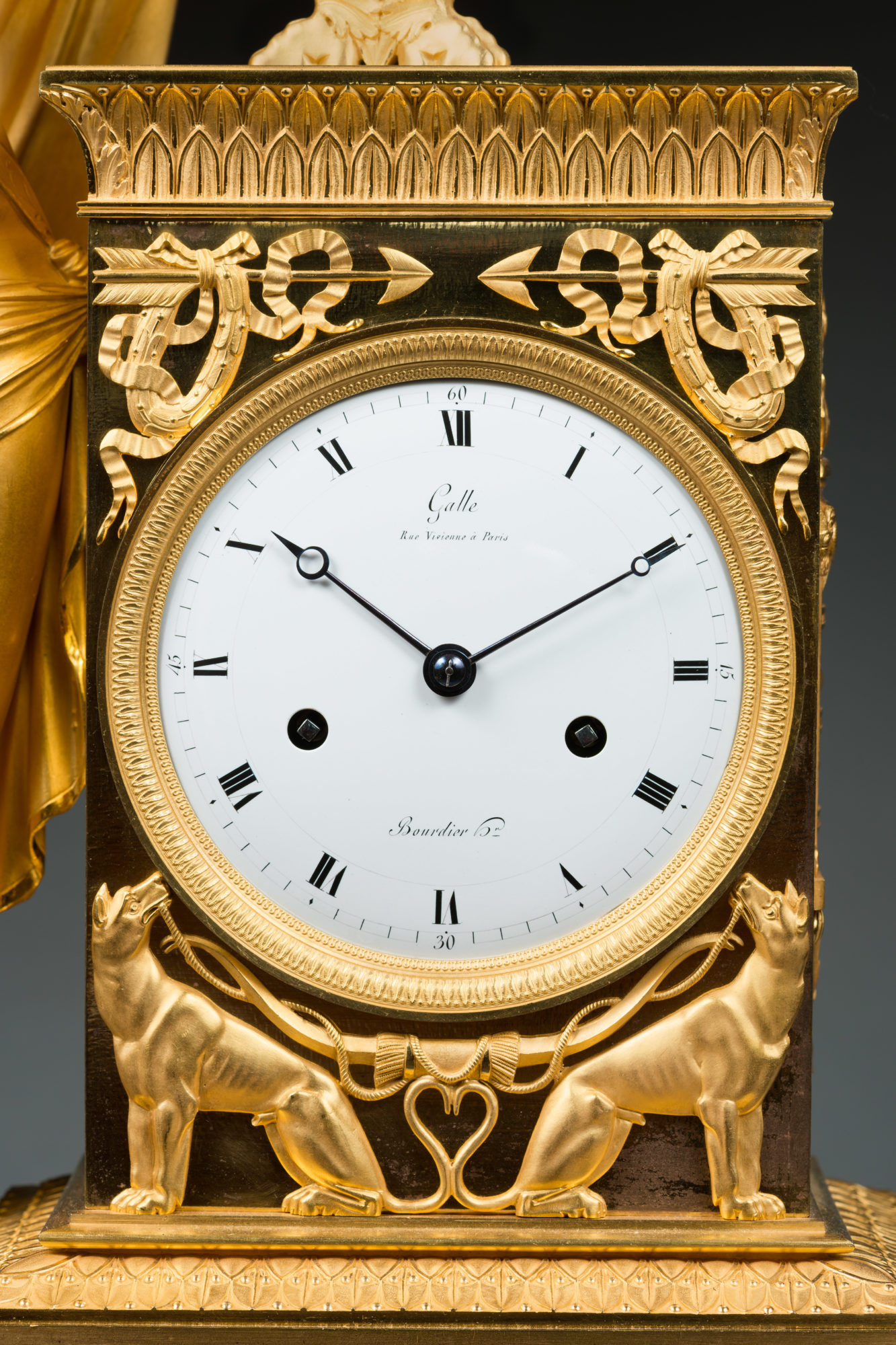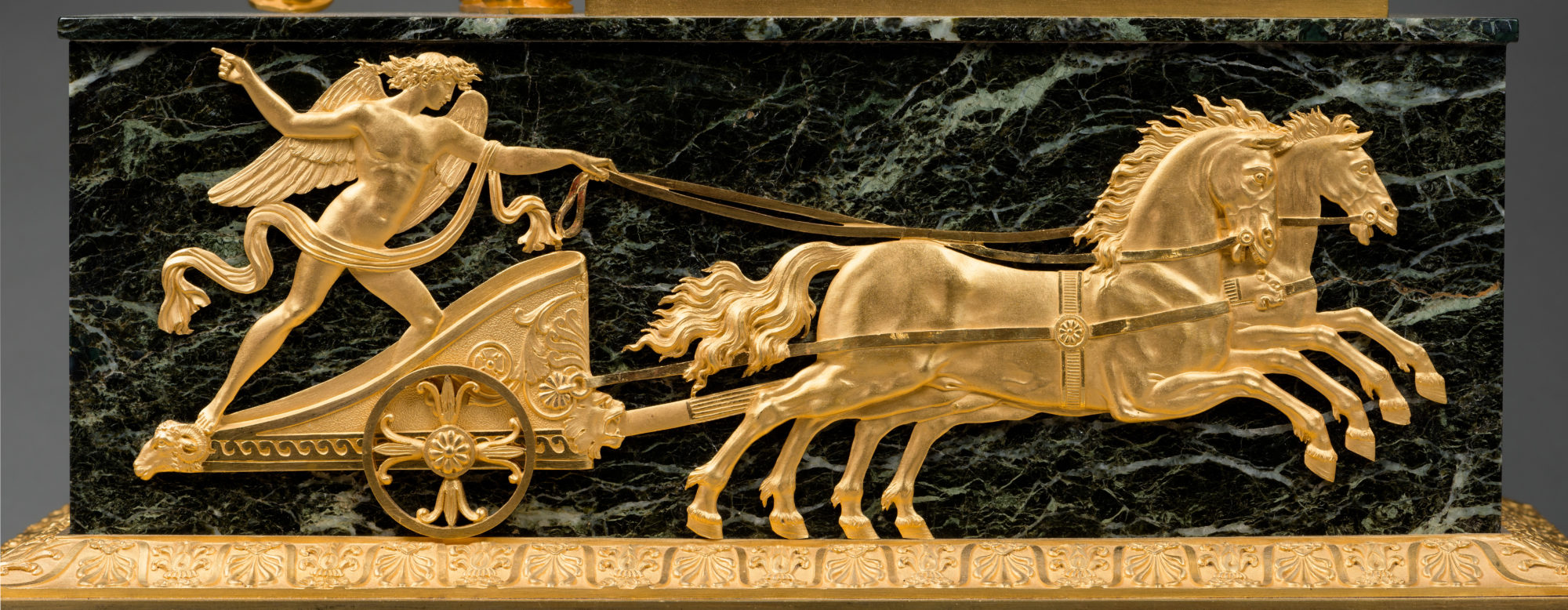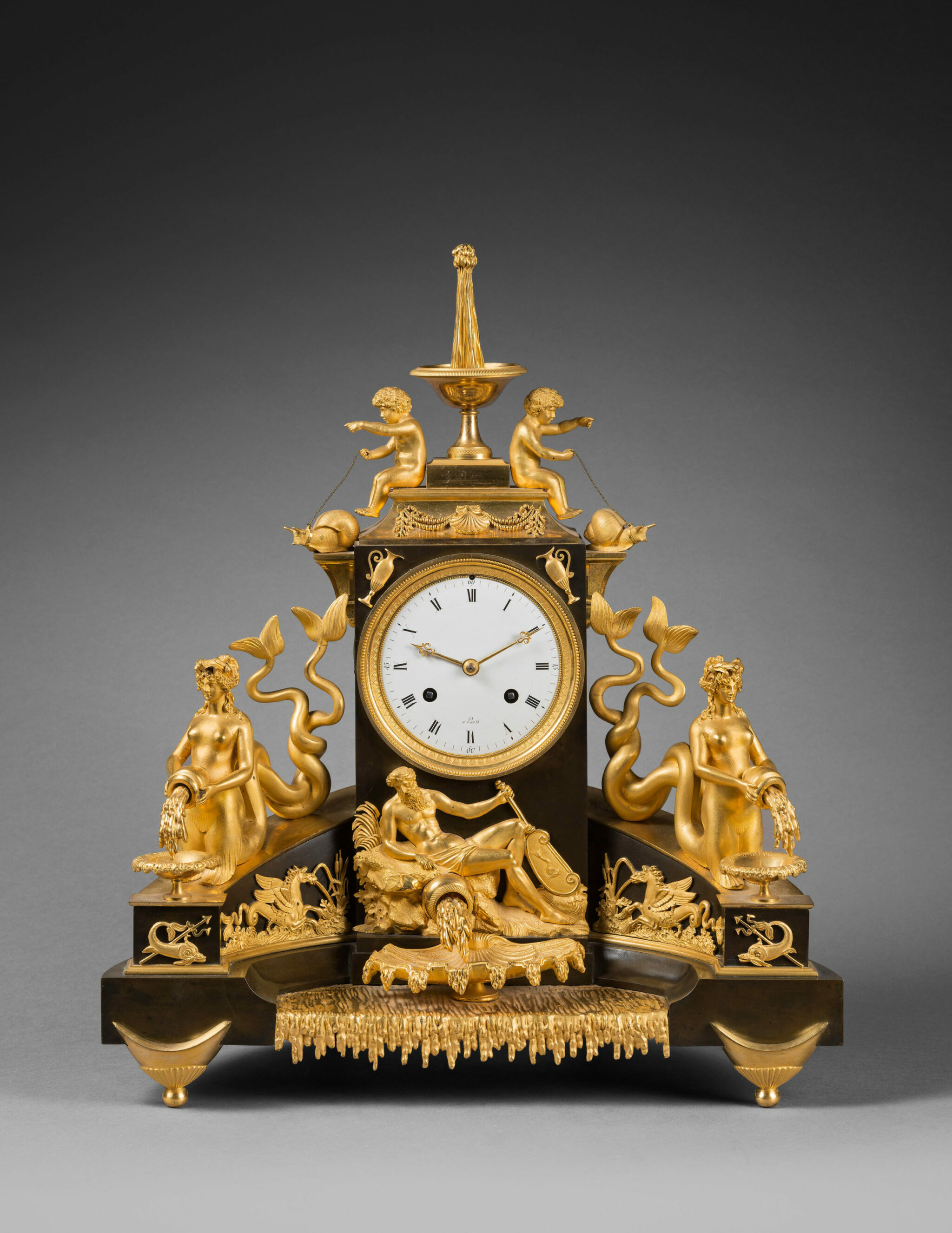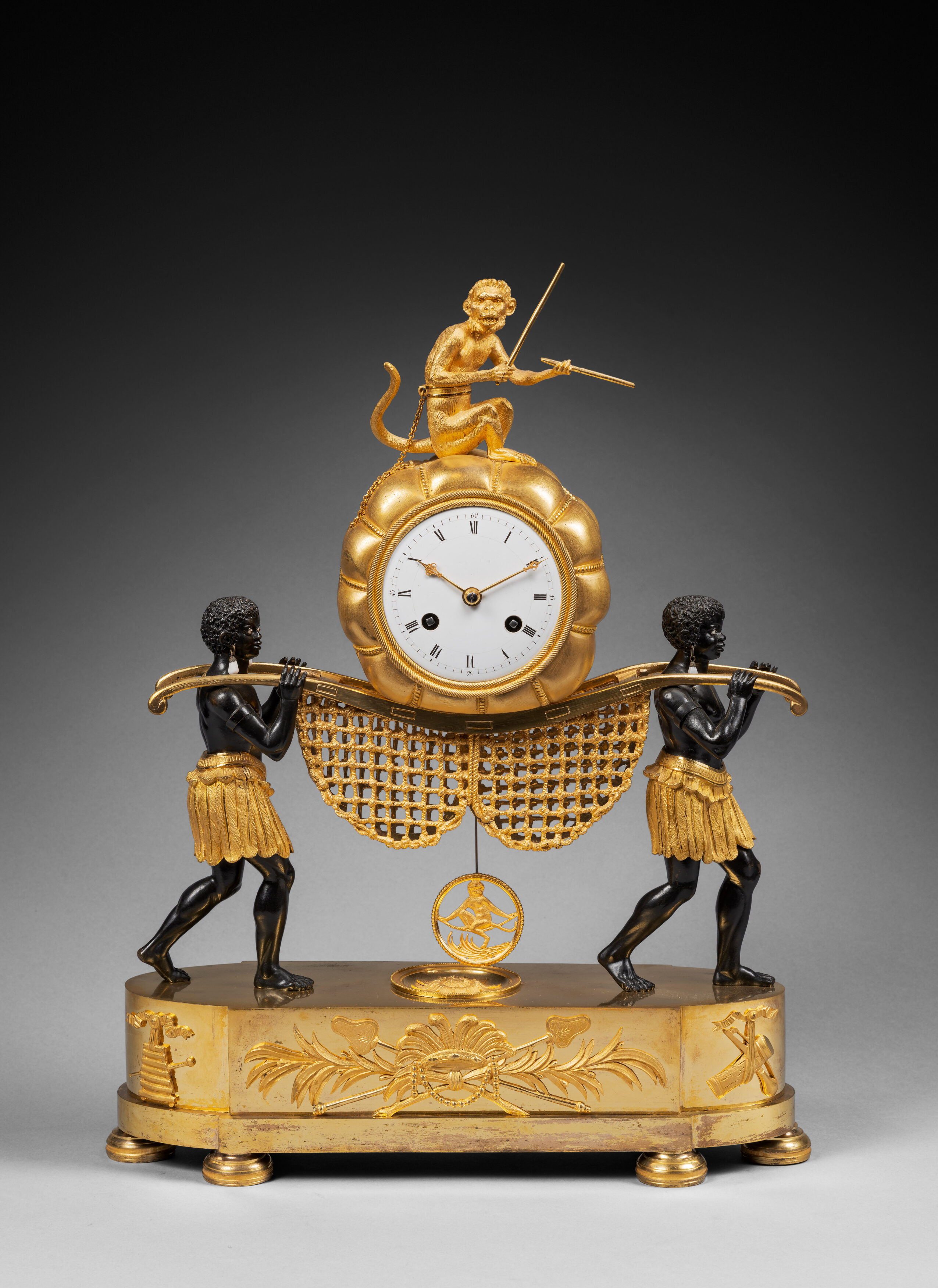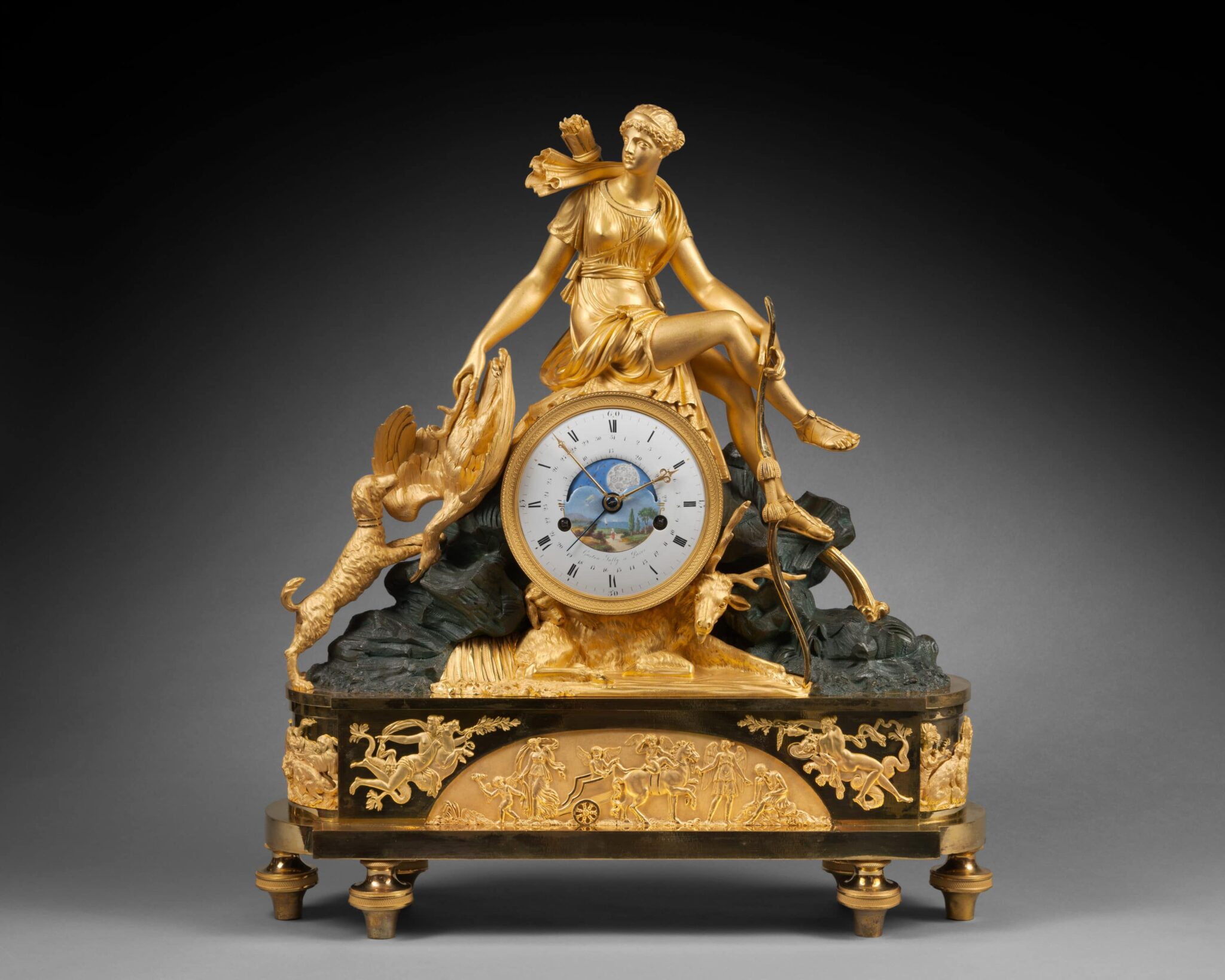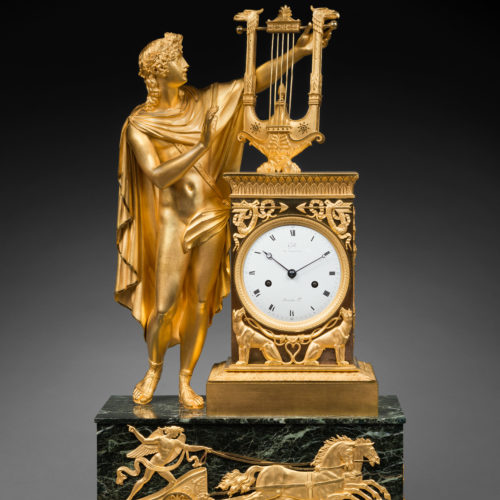Important Gilt Bronze and Green Marble Mantel Clock with Matte and Burnished Finishing
“Apollo Musagète” or “Apollo with his Lyre”
The round white enamel dial, signed “Galle/rue Vivienne à Paris” and “Bourdier Hr”, indicates the Roman numeral hours and the fifteen-minute intervals by means of two blued steel Breguet hands. The hour and half-hour striking movement is housed in a magnificent case featuring a mythological figure made of very finely chased gilt bronze with matte and burnished finishing. The rectangular case in which the movement is fitted is adorned with applied motifs of arrows tied to olive wreaths and of dogs that hold in their mouths cords wound around a bow. The upper portion, with a concave entablature decorated with a waterleaf frieze, supports a lyre with lions’ paw feet, which is decorated with scrolls and palmettes, and whose sides terminate in eagles’ heads. It is held by a magnificent standing figure representing the god Apollo, who is wearing a lightly draped tunic and sandals. The quadrangular base, whose façade is decorated with the chariot of the sun god and bears ribbon-tied wreaths on its sides, stands on a molded plinth that is adorned with a ribbon motif with alternating stylized palmettes and flowers. The clock is raised upon four robust lions’ paw feet that emerge from detailed leaves, with scrolls and rosettes.
Discover our entire collection of antique french empire mantel clocks for sale online or at the gallery.
La Pendulerie is the specialist in fine and rare antique clocks, based in Paris.
The remarkable design of the present monumental mantel clock, which displays exceptionally fine chasing and gilding, is characteristic of the finest Parisian horological creations with mythological themes dating from the late 19th century. Bearing the signatures of bronze caster Claude Galle and clockmaker Jean-Simon Bourdier, two of the most important Parisian artisans of the Empire period, it represents a type of formal clock that appears to have been quite rarely made.
Today only a small number of identical clocks are known. One clock, whose dial is signed “Galle” and “Thomas”, was sold on the French art market (illustrated in P. Kjellberg, Encyclopédie de la pendule française du Moyen Age au XXe siècle, Les éditions de l’Amateur, Paris, 1997, p. 404, fig. B). A second example, whose dial was signed “Lepaute et Fils”, is in the renowned Pitti Palace in Florence; Marcel Gay noted the clock’s 72 cm height and 45 cm width: “The ratio of these two numbers is equal to 1.6 – that is, the golden section, which adds to the importance of this magnificent composition” (see M. Gay, “Horlogerie Florentine”, in Bulletin de l’Association nationale des collectionneurs et amateurs d’Horlogerie ancienne et d’Art, Paris, autumn-winter 2010, n° 119, pp. 5-20).
Jean-Simon Bourdier (? - 1839)
Jean-Simon Bourdier is one of the most important Parisian horologists of the late 18th century and first quarter of the 19th century. He became a master on September 22, 1787 and immediately became known for the perfection of his movements. In the early 19th century, he worked with the clockmaker Godon, the designer Dugourc and the sculptor Pierre Julien, producing several remarkable pieces destined for the Spanish king Charles IV. In parallel, he worked with the most influential merchants of the time, and particularly Daguerre and Julliot, carefully choosing the artisans who collaborated with him in the production of fine clocks. Among them, one should mention the chaser Rémond, the cabinetmaker Schwerdfeger and the enamellers Dubuisson and Coteau.
Claude Galle (1759 - 1815)
One of the foremost bronziers and fondeur-ciseleurs of the late Louis XVI and Empire periods, Claude Galle was born at Villepreux near Versailles. He served his apprenticeship in Paris under the fondeur Pierre Foy, and in 1784 married Foy’s daughter. In 1786 he became a maitre-fondeur. After the death of his father-in-law in 1788, Galle took over his workshop, soon turning it into one the finest, and employing approximately 400 craftsmen. Galle moved to Quai de la Monnaie (later Quai de l’Unité), and then in 1805 to 60 Rue Vivienne.
The Garde-Meuble de la Couronne, under the direction of sculptor Jean Hauré from 1786-88, entrusted him with many commissions. Galle collaborated with many excellent artisans, including Pierre-Philippe Thomire, and furnished the majority of the furnishing bronzes for the Château de Fontainebleau during the Empire. He received many other Imperial commissions, among them light fittings, figural clock cases, and vases for the palaces of Saint-Cloud, the Trianons, the Tuileries, Compiègne, and Rambouillet. He supplied several Italian palaces, such as Monte Cavallo, Rome and Stupinigi near Turin.
In spite of his success, and due in part to his generous and lavish lifestyle, as well as to the failure of certain of his clients (such as the Prince Joseph Bonaparte) to pay what they owed, Galle often found himself in financial difficulty. Galle’s business was continued by his son after his death by his son, Gérard-Jean Galle (1788-1846). Today his work may be found in the world’s most important museums and collections, those mentioned above, as well as the Musée National du Château de Malmaison, the Musée Marmottan in Paris, the Museo de Reloges at Jerez de la Frontera, the Residenz in Munich, and the Victoria and Albert Museum in London.
Discover our entire collection of rare clocks on La Pendulerie Paris.
